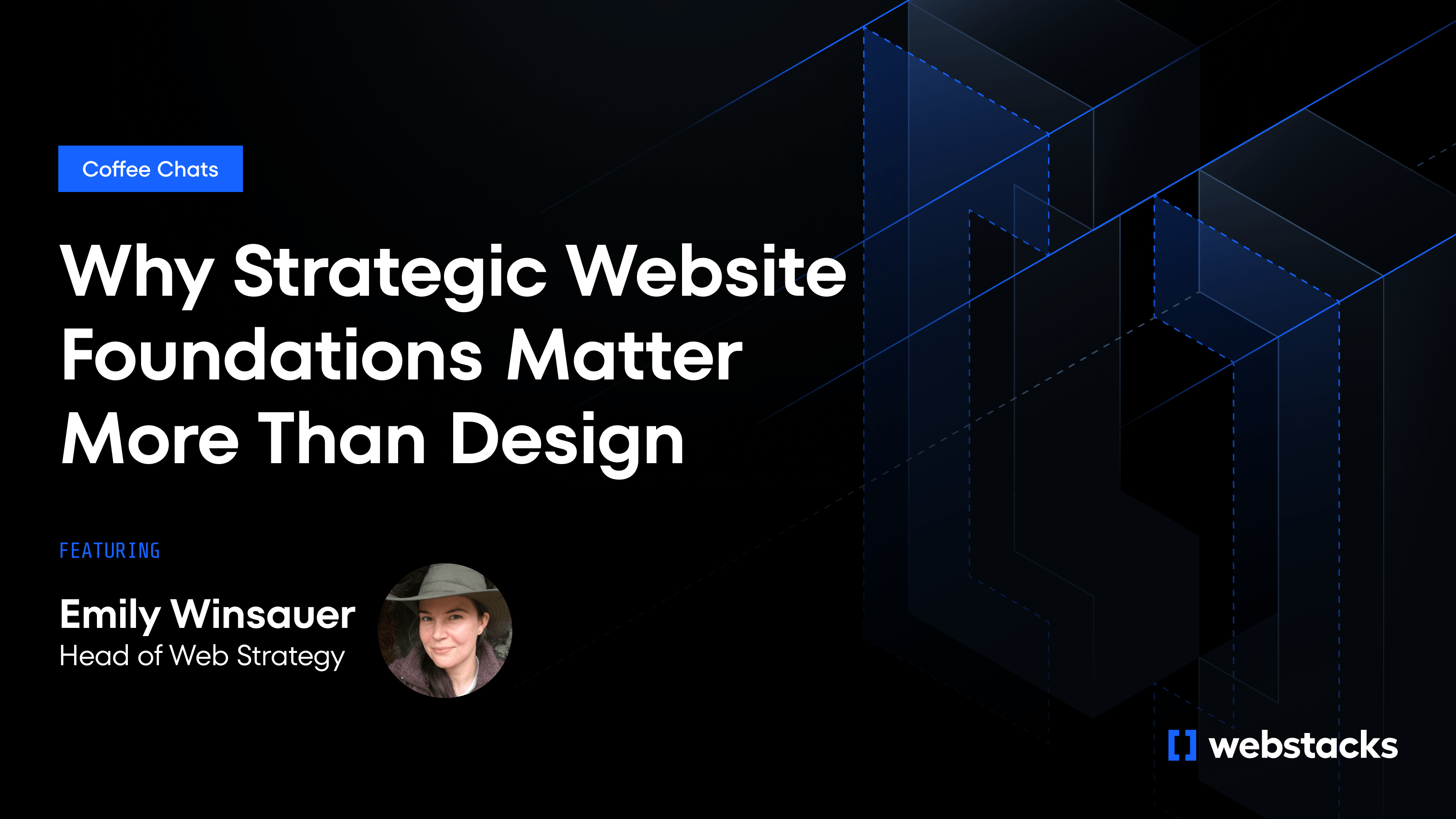Healthcare content marketing is a strategy that uses helpful, educational content to reach the right audiences and guide them through the decision-making process.
It helps healthcare and MedTech companies build trust, show up in search, and support growth through various types of formats.
As a web design and development agency, Webstacks has seen how high-impact content marketing can transform the way companies attract, educate, and retain their audience.
This guide includes 10 actionable tips and tactics to elevate your healthcare content marketing strategy. Whether you're scaling a digital team, launching a new product line, or modernizing your web presence, these insights are designed to help you:
- Align content with business goals
- Meet the needs of multi-audience stakeholders
- Streamline production and distribution
- Stay compliant in a tightly regulated space
- Drive measurable results
Let's explore how you can build a content marketing engine that's built to scale.

1. Define Clear Objectives Aligned with Business Goals
One of the most common issues in healthcare content marketing is creating content for content's sake.
Without clearly defined goals, measuring success or justifying marketing spend becomes nearly impossible.
Start with Business Outcomes
Successful healthcare content marketing starts by aligning your efforts with broader business objectives. Are you looking to:
- Generate qualified leads for a new product or service?
- Educate providers on clinical workflows?
- Improve brand visibility among payers?
- Support patient engagement and retention?
Each of these goals demands a tailored content approach. For example, thought leadership pieces support brand awareness among providers, while gated whitepapers are better suited for capturing B2B leads in enterprise sales cycles.
Set SMART Goals to Guide Strategy
To keep your content marketing focused and results-driven, use the SMART framework:
- Specific: Define the audience, intent, and channel.
- Measurable: Choose KPIs like conversion rates, page views, or email signups.
- Achievable: Ensure your goals are realistic, given your resources.
- Relevant: Tie content goals directly to sales, growth, or brand initiatives.
- Time-bound: Set clear timeframes for performance evaluation.
Look at Curative. When the company pivoted from COVID-19 testing to employer-sponsored health insurance, they needed their website to support a completely new set of business goals.
With multiple audiences—including brokers, providers, and employers—Curative worked with Webstacks to rebuild its digital presence around a scalable content model.
This included reorganizing site architecture, launching audience-specific pages, and improving search functionality. All of which supported both user needs and business outcomes like lead generation, self-service, and SEO growth.
2. Understand and Segment Your Target Audience
In healthcare content marketing, one-size-fits-all messaging doesn't cut it. Your audiences have vastly different needs, expectations, and levels of technical understanding. You need to segment your audience to engage them with personalized content.
Develop Buyer and User Personas
The first step is to build detailed personas that reflect the core segments of your audience. For MedTech and healthcare brands, these often include:
- Clinical decision-makers (e.g., physicians, hospital admins)
- Procurement teams at provider networks or payers
- End-users (patients, caregivers, or frontline healthcare workers)
- Marketing and operations teams that implement your solutions internally
Each persona should include information like job roles, challenges, goals, and preferred communication channels. For example:
- A procurement lead may need ROI calculators and vendor comparison guides.
- A patient may respond better to empathetic storytelling and how-to resources.
Match Content to Intent and Stage
Once personas are defined, map them to the customer journey, from awareness to decision-making. This helps you create content that speaks directly to their pain points at each stage. For instance:
- Awareness: Educational blog posts about emerging technologies or conditions
- Consideration: Product comparison guides or provider testimonials
- Decision: Case studies, security documentation, or implementation guides
At Webstacks, we also find that our healthcare clients need to communicate with multiple stakeholders on a single digital platform.
That requires creating dynamic, modular content experiences that surface the right message to the right user. One of the ways we help our clients achieve this is by implementing a scalable CMS that allows them to deliver tailored journeys without overloading internal teams.
3. Create Valuable and Educational Content
In healthcare, trust is everything. Your content needs to educate, inform, and empower. High-value content establishes your brand as a credible source of information and a trusted partner in care or innovation.
Focus on Substance Over Hype
Healthcare audiences are discerning. They want precise, accurate, and helpful information. That means:
- Citing credible sources and clinical data
- Avoiding exaggerated claims or clickbait
- Writing in plain language that respects your audience's time and intelligence
For MedTech and B2B healthcare brands, thought leadership is especially powerful.
Consider creating:
- Clinical explainers that unpack complex technologies
- Executive perspectives on industry trends and innovation
- Workflow guides that show how your product integrates into real settings
- Compliance and security overviews that address stakeholder concerns
Diversify Your Content Formats
Not all buyers prefer to consume information the same way. Diversifying your content formats ensures that your message reaches audiences across different learning styles and channels:
- Written: Blog posts, long-form guides, FAQs, knowledge bases
- Visual: Infographics, diagrams, slide decks
- Multimedia: Explainer videos, interviews with clinical experts, webinars
4. Use SEO
You can produce the most insightful healthcare content, but it won't move the needle if no one finds it. That's where an SEO strategy comes in.
For B2B healthcare and MedTech brands, SEO allows you to capture high-intent traffic from decision-makers actively looking for solutions.
Start with Strategic Keyword Research
Before doing keyword research, you need to understand what your target audience is searching for at each stage of their journey. Focus on:
- Pain point-driven searches (e.g., "how to reduce hospital readmissions")
- Solution-aware queries (e.g., "remote patient monitoring platforms for providers")
- Branded and competitor comparisons (e.g., “[Your product] vs. [competitor]”)
Use tools like Semrush, Ahrefs, or Google Search Console to identify opportunities that balance search volume, difficulty, and intent.
Optimize for On-Page SEO Fundamentals
Every piece of content should be optimized to help both search engines and users understand its value:
- Clear H1 and H2 structure using your target keywords
- Meta titles and descriptions that align with user intent
- Internal links to related content and service pages
- Fast load times and mobile responsiveness
- Use a smart URL structure that reflects your content hierarchy and keywords
Don't Overlook Long-Tail and Niche Queries
While high-volume keywords are important, long-tail queries often drive the most qualified traffic.
For example:
- "How to launch a HIPAA-compliant website"
- "Patient scheduling tools for multi-location dental practices"
These specific phrases signal a user is closer to purchase or action, and often face less competition.
Combine your SEO strategy with an engaging web design to encourage users to spend more time on your site.

5. Use Multi-Channel Distribution
In addition to search engines, you should also consider other channels for content distribution.
Choose Channels That Fit Each Audience
Different stakeholders consume content differently:
- Healthcare executives prefer LinkedIn, whitepapers, and industry publications
- Clinicians engage with email newsletters, research summaries, and peer recommendations
- Patients respond to SEO-optimized blog content, explainer videos, and social posts
Map your content formats to the platforms your personas use most. For example:
- Promote a blog post via a paid LinkedIn campaign targeting hospital CMOs
- Repurpose a case study into short, engaging social clips for brand visibility
- Turn a webinar into a gated asset promoted through email nurture flows
Maintain a Consistent Brand Voice Across Channels
Healthcare brands must maintain a consistent, credible tone across all platforms. That doesn't mean every message sounds identical, but your visual identity, messaging pillars, and core positioning should be unified.
But this is challenging without the right tech stack.
A modular content strategy, supported by a flexible CMS, helps you reuse and adapt assets but stay on-brand.
6. Implement Marketing Automation and CRM Integration
Speed and personalization are important for modern healthcare marketing, and that's where marketing automation and CRM integration make a measurable difference. These tools allow MedTech teams to scale efforts when it comes to building tailored experiences.
Automate Workflows to Save Time and Improve Conversion
Marketing automation platforms (like HubSpot email automation, Marketo, or Pardot) simplify how you distribute, personalize, and measure your content. Use automation to:
- Send targeted follow-ups based on content engagement
- Nurture leads with educational drip campaigns
- Trigger content offers based on behavior (e.g., downloading a guide or attending a webinar)
Integrate CRM for Full-Funnel Visibility
When your marketing automation platform connects to your CRM (e.g., Salesforce), you can see the customer journey completely. This enables:
- Smarter segmentation based on firmographics, behaviors, or clinical role
- Attribution tracking to see which content drives pipeline or revenue
- Sales and marketing alignment through shared data and lead insights
CRM integration also supports compliance for healthcare marketing teams by ensuring contacts are opted-in and data is appropriately managed.
7. Measure Performance and ROI
All marketers, including those in healthcare, are under increasing pressure to show results. Here's how you can tie your content marketing efforts to measurable outcomes.
Track Metrics That Align with Your Goals
Choose KPIs that reflect both marketing performance and business impact. These may include:
- Traffic metrics: Organic visits, referral sources, bounce rate
- Engagement metrics: Time on page, scroll depth, content shares
- Conversion metrics: Form submissions, demo requests, gated content downloads
- Revenue metrics: Contribution to pipeline, influenced deals, customer acquisition cost (CAC)
For example, if your goal is lead generation, focus on metrics like conversion rate per asset, MQL-to-SQL ratio, and cost per lead. If it's thought leadership, track backlinks, share velocity, and engagement rates.
Also, make sure that your website is optimized for conversions. Does it have CTAs that grab the user’s attention? If this element is missing, even great content might not deliver the kind of ROI you are hoping for.
Use Dashboards to Monitor and Share Results
Build dashboards in platforms like HubSpot, Google Analytics, or Looker, to allow stakeholders to monitor performance. These should:
- Tie content performance to stages in the buyer journey
- Show trends over time and across content types
- Surface insights that help refine the strategy
Remember: not all wins are immediate. Especially in healthcare, where buying cycles are longer and more collaborative, content influence can be a slow burn. That makes tracking multi-touch attribution even more important.
Optimize Based on Insights
Content marketing is never "done." Use performance data to:
- Refresh or expand high-performing assets
- Identify content gaps or drop-off points in the funnel
- Improve CTAs, distribution timing, or topic targeting
Continuous measurement and optimization can significantly improve website ROI and drive better results. At Webstacks, we encourage clients to treat their website and content ecosystem like a product, constantly iterating based on what works.
8. Ensure Compliance
As a healthcare organization, your marketing team also has to account for regulatory compliance to avoid hefty legal fees and reputational damage.
Specifically, marketers must be vigilant about staying compliant with regulations such as:
- HIPAA (Health Insurance Portability and Accountability Act): Do not include Protected Health Information (PHI) in your content or analytics tracking unless it is appropriately de-identified and secured.
- FDA Guidelines: These are especially relevant for MedTech and pharma companies. Ensure claims about medical devices or treatments are substantiated and follow promotional guidelines.
- GDPR/CCPA: If you're marketing to EU or California residents, data collection and cookie policies need to be fully transparent and legally compliant.
Work closely with your legal or compliance team to review:
- Content messaging and disclosures
- Forms and data capture practices
- Tracking tools and integrations
Use Language That Builds Trust and Accuracy
Healthcare content should always be:
- Accurate: Fact-checked with up-to-date clinical data or peer-reviewed sources
- Clear: Free of jargon or vague marketing language that could be misleading
- Sensitive: Written with empathy, especially when discussing patient outcomes, diseases, or care experiences
Avoid overpromising outcomes or using fear-based tactics that violate ethics and compliance standards.
A modern CMS can help enforce compliance workflows, such as user permissions, review queues, and content versioning. Webstacks helps clients integrate governance into their digital platforms so that compliance isn't a bottleneck but a built-in process. The approach ensures marketers can move quickly while staying within guardrails.
9. Foster Collaboration Between Marketing and Clinical Teams
Marketing in the healthcare and MedTech space doesn't happen in a vacuum. To create accurate and compelling content, marketers should work closely with clinical experts, product teams, and other internal stakeholders.
Bridge the Gap Between Strategy and Subject Matter Expertise
Clinicians and care teams often hold the insights buyers care about—like how a product improves workflows or patient outcomes. Marketing teams should regularly tap into this expertise through:
- Interviews and SME (subject matter expert) workshops
- Joint content planning sessions
- Feedback loops for clinical accuracy and tone
Involve Clinical Stakeholders in Early
Rather than pulling in clinical voices at the end for review, involve them early in the content process. This improves:
- Speed: Fewer revisions and clearer expectations
- Accuracy: Early validation of claims and frameworks
- Buy-in: Better internal alignment across departments
For example, a blog post on AI-assisted diagnostics is far more credible when it includes input or co-authorship from a physician or lab director.
10. Stay Updated with Industry Trends
New technologies, regulations, and patient expectations are always emerging. So always stay on top of the latest developments:
- Track trends in digital health, MedTech innovation, and health IT adoption
- Attend virtual or in-person industry events to hear what's top-of-mind for your audience
- Subscribe to regulatory updates from CMS, HHS, and other key organizations
Create content that helps your audience make sense of these shifts, before your competitors do.
Respond to Changing Buyer Behavior
Decision-makers are researching more independently and expecting faster answers. That means:
- Optimizing content for mobile, voice, and visual consumption
- Making value propositions clear within seconds of landing on a page
- Building self-serve content hubs for different personas and stages
In other words, your content needs to be discoverable, skimmable, and actionable.
Build a Content Engine That Scales with Your Healthcare Brand
The strategies we have covered in this guide will help your healthcare or MedTech brand transform content from a reactive activity into a proactive growth engine.
At Webstacks, we partner with healthcare and MedTech organizations to build scalable digital platforms—from CMS implementations to full-blown redesigns. Schedule a call to learn more about how we can help with your website, branding, SEO, and more.




